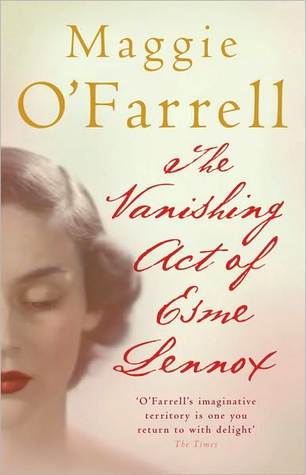Our book group choice for November 2010 is The Vanishing Act of Esme Lennox by Maggie O’Farrell. In the middle of tending to the everyday business at her vintage-clothing shop and sidestepping her married boyfriend’s attempts at commitment, Iris Lockhart receives a stunning phone call.
Her great-aunt Esme, whom she never knew existed, is being released from Cauldstone Hospital where she has been locked away for more than sixty-one years.
Iris’s grandmother Kitty always claimed to be an only child. But Esme’s papers prove she is Kitty’s sister, and Iris can see the shadow of her dead father in Esme’s face.
Esme has been labeled harmless—sane enough to coexist with the rest of the world. But she’s still basically a stranger, a family member never mentioned by the family, and one who is sure to bring life-altering secrets with her when she leaves the ward. If Iris takes her in, what dangerous truths might she inherit?
A gothic, intricate tale of family secrets, lost lives, and the freedom brought by truth, The Vanishing Act of Esme Lennox will haunt you long past its final page.
The Vanishing Act of Esme Lennox Discussion Questions
- How do the Dickinson and Wharton epigraphs at the beginning of the book relate to and set the stage for the novel? In what way do they put the book in the context of a larger literary tradition? Are there other books or authors who seem appropriate for epigraphs for this book? Why?
- Some of the earliest scenes Esme shares with the reader are those from her childhood in India. What do these scenes, particularly the ones on pages 4–8, reveal about Esme and her family? What do they reveal about their place in time and society?
- Iris notes on page 10 that sometimes she feels as though she is leading a “subterranean existence.” What does she mean? In what ways is this type of existence similar to or different from those of the other female characters?
- Iris and Alex seem to live in their own world, keeping others—even Alex’s wife and Iris’s lovers—on the outside. How does the author let you know that Iris doesn’t like Fran without coming out and saying so? How does she reveal that Alex and Luke don’t like each other? How do these revelations serve a function in the progress of the novel?
- O’Farrell’s novel is steeped in secrets. As the story of Esme and Kitty unfolds simultaneously with the story of Iris and Alex, O’Farrell offers clues about the true nature of the relationships between these characters. What effect does this have on your compassion for them? How do these two stories relate to each other?
- Why is Esme purportedly admitted to Cauldstone? Why do you think she was sent there, and never sent home? Is she really mad? Give examples from the book to support your opinion.
- Esme is both taken aback and fascinated by many things that Iris shows and tells her. What does Esme think is so remarkable about Iris? How are Iris and Esme similar? How are they different?
- On page 57, Iris discovers some of the more outrageous reasons that women in the mid-nineteenth and early twentieth centuries were sent to “mad houses” like Cauldstone. Given how life was during that period, according to the novel’s descriptions, what do you think drove this trend? Do you think changes have occurred in our view and treatment of women who don’t “behave”? Why or why not?
- O’Farrell creates distinct voices for the three main characters in her novel and shifts between these points of view to tell her story. Why do you think the author made this choice? What do these different voices reveal about Iris, Esme, and Kitty? How does this technique affect your reading experience?
- Identify some of the various ways in which the title, The Vanishing Act of Esme Lennox, relates to the story. What does Esme’s description of her “vanishing act” on page 91 symbolize?
- The references to Kitty stealing Esme’s jacket and the image of Esme holding on to baby Hugo are introduced early to distract the reader from the true secret of this story. When did you figure out what it was that Kitty really took from Esme? How did it affect your opinion of Kitty? Do you feel sympathy for her? Why or why not?
- How does Esme and Kitty’s secret change things for Iris? Is Alex right when he tells Iris, “It’s only ever been you and you know it’s only ever been me”? Now that the full weight of Esme’s tragedy has unfolded, do you think Iris will choose to be with him or with Luke?
- Alex and Luke are both married men in love with Iris. Do you think this is why they so dislike each other? Is there a difference between their situations? Do you think Iris really loves either one of them? Why or why not?
- What do you make of the ending? What do you imagine will happen to these characters after the last page is turned? Has the author satisfied your interest in these characters? Does there seem to be an overarching message?

